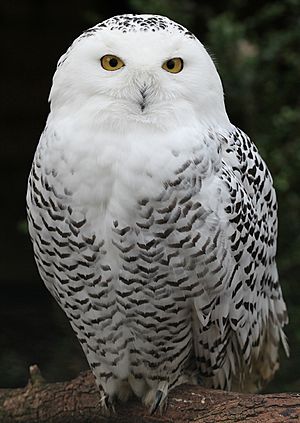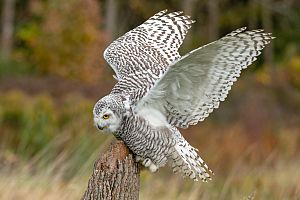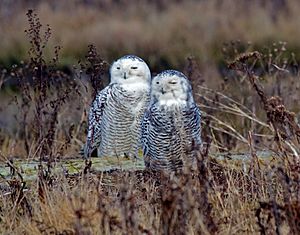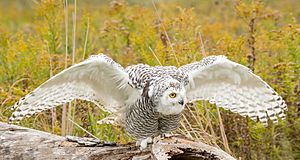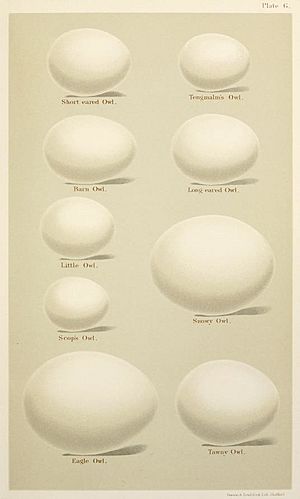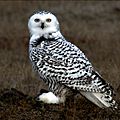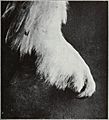Snowy owl facts for kids
Quick facts for kids Snowy owl |
|
|---|---|
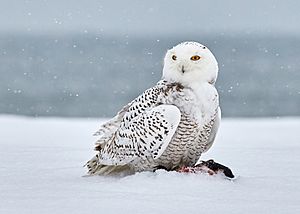 |
|
| Conservation status | |
| Scientific classification | |
| Genus: |
Bubo
|
| Species: |
scandiacus
|
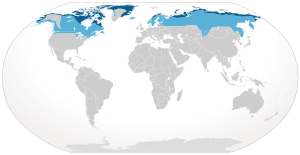 |
|
Breeding Non Breeding |
|
| Synonyms | |
|
|
The snowy owl (Bubo scandiacus) is a beautiful, large white owl. People also call it the polar owl, the white owl, or the Arctic owl. It belongs to the family of "true owls."
Contents
What Does a Snowy Owl Look Like?
The snowy owl is one of the biggest owl species. It is the only owl that is mostly white. When you see them in nature, they can look like a pale rock or a pile of snow. This helps them blend in with their surroundings.
Male snowy owls are usually a purer white. Female owls often have more dark brown spots or flecks. Young male snowy owls have dark marks that look like females until they grow up. You can tell an owl's age and sex by looking at these markings.
Snowy owls have bright yellow eyes. Their eyesight is very good for seeing things far away. It is not as good for seeing things up close. Like other owls, snowy owls can probably see all colors. However, they cannot see ultraviolet light.
Their head is quite small, and their face is not very deep. Owls have the largest brains of any bird. The size of their brain and eyes helps them hunt at night. It also helps them be good predators.
How Big Are They?
The snowy owl is a very large owl. They are the biggest bird predators in the High Arctic. They are also among the largest owls in the world. Snowy owls are usually the sixth or seventh heaviest owls. They are about the fifth longest and perhaps the third longest-winged.
Female snowy owls are bigger than males. This helps them survive when there is not much food. This is especially important when they are laying eggs or taking care of their young. Male snowy owls can be about 52.5 to 64 centimeters (20.7 to 25.2 inches) long. Females can be from 54 to 71 centimeters (21 to 28 inches) long.
What Sounds Do They Make?
Scientists have recorded about 15 different calls from adult snowy owls. Their main call is a repeated sound. It usually has 2 to 6 rough notes. It sounds a bit like a barking dog: krooh krooh krooh krooh.
The call might end with a strong aaoow. This sound is a bit like the alarm call of a large seagull. They usually call from a perch, but sometimes they call while flying.
Female snowy owls also make chirping sounds and high-pitched screams. These sounds are similar to their baby owls. Both male and female owls might make clucking, squealing, grunting, hissing, and cackling sounds. They might do this when they are excited. Their alarm call is a loud, harsh keeea.
Another rough barking sound is sometimes called a "watchman's rattle." It can sound like rick, rick, rick or kre, kre, kre, kre, kre. A female protecting her nest was heard making a crow-like ca-ca-oh call.
Where Do Snowy Owls Live?
Snowy owls live in the Arctic parts of North America and Eurasia. They mostly breed on the tundra.
In winter, many snowy owls fly south to warmer places. They regularly spend winter in places like Iceland, Ireland, and Scotland. They also go to northern Europe and parts of Asia. In North America, they often winter in southern Canada.
The ground where snowy owls breed has mosses, lichens, and some rocks. They often like areas with higher ground. These can be hummocks, knolls, ridges, bluffs, and rocky outcrops.
When it's not breeding season, snowy owls can live in almost any open area. Their winter homes are usually windy with little cover. These open areas include coastal dunes, coasts, lakeshores, islands, moorlands, steppes, meadows, and prairies. They also like grasslands and shrubby areas in the Subarctic.
How Do Snowy Owls Behave?
Most owls sleep during the day and hunt at night. But snowy owls are often active during the day. This is especially true in the summer.
Snowy owls often spend most of their time on the ground. They prefer to sit on flat surfaces. However, they might perch on hummocks, fenceposts, telegraph poles, radio and transmission towers. They also use haystacks, chimneys, and roofs of buildings when they are hunting.
What Do Snowy Owls Eat?
The snowy owl is a hunter that can eat many different things. They can adapt to almost any prey they find. Most often, they eat small mammals like lemmings. They also eat northern water birds. Sometimes, they will eat carrion (dead animals).
Birds they eat often include small songbirds, northern seabirds, ptarmigan, and ducks. Sometimes, they also eat beetles, crustaceans, amphibians, and fish.
Snowy owls catch and eat their prey on the ground. Like other meat-eating birds, they often swallow small prey whole. Their strong stomach juices break down the meat. The parts they cannot digest, like bones, teeth, fur, and feathers, are formed into oval pellets. The owl spits out these pellets 18 to 24 hours after eating.
Snowy Owl Families: Reproduction
Snowy owls usually build their nests on a small rise on the tundra ground. The female owl lays many eggs, often from 5 to 11. The eggs are laid and hatch at different times. Even though the Arctic summer is short, the young owls take a long time to grow. They become independent in the autumn.
The snowy owl is a nomadic bird. This means they do not usually breed in the same places each year. They also do not often breed with the same mate. If there is not enough food, they might not breed at all.
Most snowy owls arrive at their nesting site in April or May. A few stay in the Arctic all winter. The male owl shows possible nest spots to his mate. He does this by scratching the ground and spreading his wings over it. The nest is usually a shallow dip on a windy spot in the open tundra.
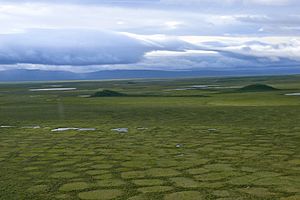
Egg-laying usually starts in early May to the first 10 days of June. The number of eggs can vary a lot, usually around 7 to 9. In extreme cases, up to 15 or 16 eggs have been recorded. The female owl lays one egg after another. The time between laying eggs can be 3 to 5 days if the weather is bad. The female starts sitting on the eggs (incubation) with the first egg. She does this alone, and the male brings her food.
How Long Do Snowy Owls Live?
Snowy owls can live a long time for a bird. Records show that snowy owls in zoos can live to be 25 to 30 years old. In the wild, they usually live for about 10 years. The longest known lifespan in the wild was almost 24 years. This owl was tagged in Massachusetts and later found in Montana.
Who Hunts Snowy Owls?
Larger birds sometimes hunt snowy owls, especially in winter. However, these attacks are rare. Eurasian eagle-owls have been known to hunt snowy owls in winter. Golden eagles and all northern sea eagles also hunt them. This includes the bald eagle, white-tailed eagle, and Steller's sea eagle.
Snowy owls are also sometimes killed by birds that "mob" them. Mobbing is when many smaller birds attack a larger bird to drive it away. In one case, a peregrine falcon killed a snowy owl. This happened after the owl had killed a young falcon. There are also stories of gyrfalcons attacking snowy owls. In another case, a huge group of Arctic terns attacked a snowy owl until it died.
Are Snowy Owls in Danger?
The number of snowy owls depends on how much food is available. In years when there are many lemmings, snowy owls can seem very common. It is hard to count snowy owls because adult owls move around a lot.
However, recent information suggests that their numbers are dropping quickly. The global population was once thought to be over 200,000 owls. Now, there are probably fewer than 100,000 worldwide. The number of breeding pairs might be 28,000 or even less. Scientists do not fully understand why their numbers are falling. But environmental factors, like global warming, are likely a threat. Because their population is small and shrinking fast, the snowy owl was listed as a vulnerable species in 2017. This was done by the IUCN.
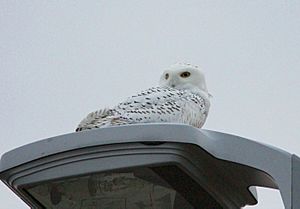
Snowy Owls in Books and Movies
- The Harry Potter books by J. K. Rowling feature a female snowy owl named Hedwig. She is also in the films. Some people worried that the movies would cause more illegal trade of snowy owls. However, there was no strong proof of an increase in snowy owls taken from the black market. Still, more snowy owls than usual were reported at wildlife centers.
- The EADS Harfang is a drone aircraft used by the French Air Force. It is named after the snowy owl (Harfang des neiges in French).
- The snowy owl (harfang des neiges in French) is the official bird symbol of Quebec, Canada.
- "White Owl" is a brand of cigars that uses the snowy owl in its advertisements.
Images for kids
-
The engraving Snowy Owl, Plate 121 of The Birds of America by John James Audubon. Male (top) and female (bottom).
-
A young owl on the tundra at Utqiaġvik, Alaska. Snowy owls lose their black feathers as they get older.
-
Bobby Tulloch, a wildlife warden, at a snowy owl nest on the island of Fetlar, Shetland, in August 1967.
-
Lemmings, like Norway lemmings, are the main food for breeding snowy owls.
-
A snowy owl carrying an American black duck it caught in Biddeford Pool, Maine.
-
An old drawing showing a snowy owl being hunted by a gyrfalcon.
-
An old photo of snowy owl babies on Baffin Island.
See also
 In Spanish: Búho nieve para niños
In Spanish: Búho nieve para niños




